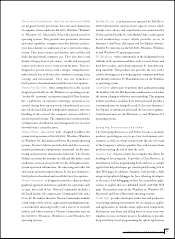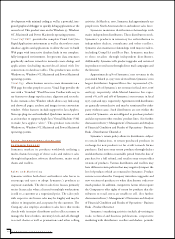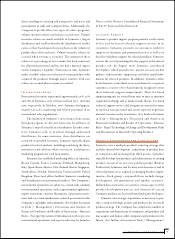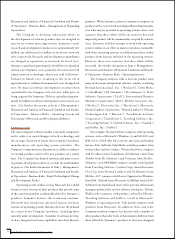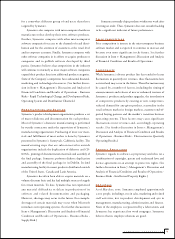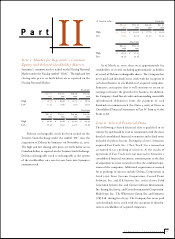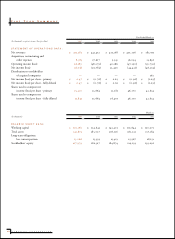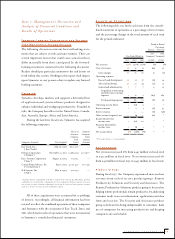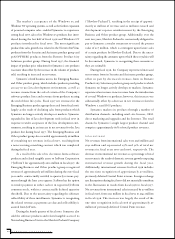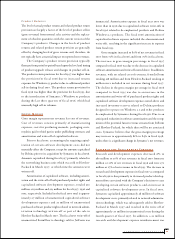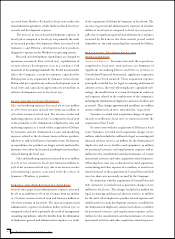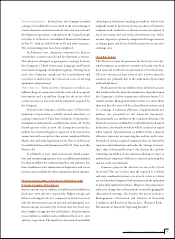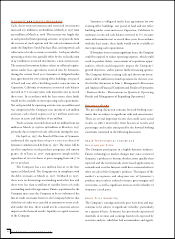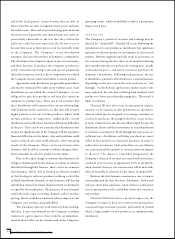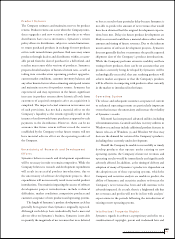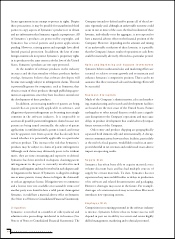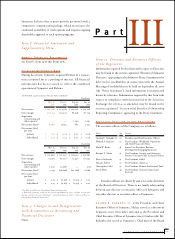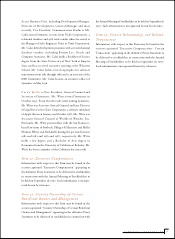Symantec 1997 Annual Report Download - page 23
Download and view the complete annual report
Please find page 23 of the 1997 Symantec annual report below. You can navigate through the pages in the report by either clicking on the pages listed below, or by using the keyword search tool below to find specific information within the annual report.
P r oduct Returns
The level of actual product returns and related product return
provision are largely a factor of the level of product sell-in
(gross revenue) from normal sales activity and the replace-
ment of obsolete quantities with the current version of the
Company’s products. Changes in the levels of product
returns and related product return provision are generally
offset by changing levels of gross revenue and, therefore, do
not typically have a material impact on reported net revenues.
The Company’s product return provision typically
fluctuate from period to period based upon the level and timing
of product upgrade releases and changes in product sell-in.
The product return provision for fiscal 1997 was higher than
the provision for fiscal 1996 due to increased returns
exposure for Windows 95 products due to additional product
sell-in during fiscal 1997. The product return provision for
fiscal 1996 was higher than the provision for fiscal 1995, due
to the introduction of Symantec’s Windows 95 products
during the last three quarters of fiscal 1996, which had
unusually high sell-in volumes.
Gross Margin
Gross margin represents net revenues less cost of revenues.
Cost of revenues consists primarily of manufacturing
expenses, costs for producing manuals, packaging costs,
royalties paid to third parties under publishing contracts and
amortization and write-off of capitalized software.
Prior to fiscal 1997, accounting rules requiring capital-
ization of certain software development costs did not
materially affect the Company, except for amounts capitalized
by Delrina prior to its acquisition by Symantec in fiscal 1996.
Amounts capitalized during fiscal 1997 primarily related to
the networking business unit which was sold to Hewlett-
Packard in March 1997, at which time the amounts were
written off.
Amortization of capitalized software, including amorti-
zation and the write-off of both purchased product rights and
capitalized software development expenses, totaled $10
million, $19 million and $13 million for fiscal 1997, 1996 and
1995, respectively. Included in the fiscal 1997 total is approx-
imately $7 million of unamortized capitalized software
development expenses and $1 million of unamortized
purchased software product rights related to network admin-
istration technology written off as part of the sale to
Hewlett-Packard in March 1997. The fiscal 1997 write-off of
unamortized FormFlow technology sold to JetForm was
immaterial. Amortization expense in fiscal year 1997 was
lower than in 1996 due to capitalized software write-offs in
fiscal 1996 related to de-emphasized products and Delrina
Windows 3.1 products. The fiscal 1996 amortization of
capitalized software expense included the aforementioned
write-offs, resulting in the significant increase in expense
from fiscal 1995.
Gross margins increased to 80% of net revenues in fiscal
1997 from 75% in fiscal 1996 and from 79% in fiscal 1995.
The increase in gross margin percentage in fiscal 1997
compared to fiscal 1996 was due to the decrease in capitalized
software amortization and write-offs noted above. In addition,
revenues, with no related cost of revenues, from JetForm
totaling $18 million and from Hewlett-Packard totaling $1
million were included in net revenues during fiscal 1997.
The decline in the gross margin percentage in fiscal 1996
compared to fiscal 1995 was due to an increase in the
amortization and write-off of purchased product rights and
capitalized software development expenses noted above and
increased inventory reserves related to Delrina products
designed to operate on Windows 3.1 and other products
de-emphasized by Symantec during fiscal 1996. Due to an
anticipated reduction in software amortization and the recog-
nition of the potential future revenue streams from JetForm
and Hewlett-Packard, for which there will be no associated
costs, Symantec believes that the gross margin percentage
may increase to approximately 81% to 84% in fiscal 1998,
unless there is a significant change in Symantec’s net revenues.
Research and Development Expenses
Research and development expenses decreased 6% to
$89 million or 19% of net revenues in fiscal 1997 from $95
million or 21% of net revenues in fiscal 1996 and were $71
million or 17% of net revenues in fiscal 1995. The decrease in
research and development expenses in fiscal 1997 as compared
to fiscal 1996 is due primarily to decreased product develop-
ment efforts associated with the Company’s decision to cease
developing certain software products, and an increase in
capitalized software development costs. In fiscal 1997,
Symantec capitalized approximately $8 million of software
development costs, primarily related to network administra-
tion technology, which was subsequently sold to Hewlett-
Packard in March 1997 and resulted in the write off of
approximately $7 million in unamortized costs during the
fourth quarter of fiscal 1997. In addition, a $2 million
research and development expense reimbursement was
21
SYMANTEC CORPORATION


